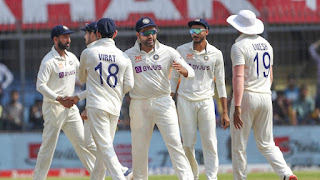India knew they could only hope to survive when they started the third day's sessions, and they succeeded in doing so. However, by stumps, Australia's hold had become tighter.
Match Summary:
Australia 123 for 4 (Labuschagne 41*, Jadeja 2-25) and 469 lead India 296 (Rahane 89, Shardul 51, Cummins 3-83) by 296 runs
The third day of the WTC final saw India hold on admirably thanks to valiant runs from Ajinkya Rahane and Shardul Thakur and stronger bowling than in the first innings, but by the day's conclusion it was clear they had lost too much ground on the first two days. They started the day 318 behind after losing half of their team, miraculously managed to close the gap to 173, but concluded the day 296 behind with six Australian wickets still intact.
India went into every session of the day knowing that the best they could hope for was to survive. Despite managing to avoid being struck by a storm, Australia advanced steadily in the lengthy final session to leave India somewhere between just alive and out of the game.
In his second ball of the day, Scott Boland bowled KS Bharat after starting metronomically and slipping under his inside edge. Rahane and Thakur, the two batters, were then subjected to unbalanced pitch bounce from Pat Cummins and Boland. They were swift and relentless for the better part of the opening hour. Both of Thakur's forearms had to be padded, and he had to take a painkiller.
However, Australia's performance in the field was far from flawless. In the end, Cummins had six no-balls and three of them resulted in wickets. He missed out on Thakur's wicket on day three after Rahane and Ravindra Jadeja on day two. The slip cordon saw three catches fall. Mitchell Starc fought to maintain composure.
Rahane and Thakur started to score often once they neutralised the threat posed by Cummins and Boland. By lunchtime, Thakur was 14 shy of a third fifty in three innings at The Oval, and Rahane was 11 short of what would have been a memorable century on Test homecoming. By this point, the 60-over old ball had ceased acting up, and India had a strong chance of drastically reducing the 209-run deficit before the second new ball.
However, after lunch, Rahane chased a widish delivery and edged it, only for Cameron Green to make an amazing catch in the gully. Even though Thakur was able to reach his half-century, the next three wickets could only add 35.
India's bowling was more controlled than it was in the opening innings. After cutting David Warner off early, Mohammed Siraj in particular got uneven bounce. On hit, the bat twice flew out of Marnus Labuschagne's hands, just as it had with Thakur before. He was once carried away. Usman Khawaja wafted at a wide delivery, giving Umesh Yadav his first wicket of the game, which let him capitalise on the pressure.
With Labuschagne struggling, India would have hoped for additional gains at 24 for 2, but Steven Smith played an easy knock to set India back. Smith, who had prepared himself for a lengthy dig in the first innings, suddenly sought out early runs, scoring 12 runs off of his first seven balls. Smith appeared to be on track for a huge, simple knock as India's second line of quick bowlers started to bowl with wide-open fields.
The third time during the Test, Smith then attempted to attack Jadeja. He avoided mid-off on the first two occasions, in the first innings, but this time the surface had enough grip to allow him to take the edge for point and make the catch. It was a relief for India to dismiss Smith for just 34 runs as he was batting with a control rate of more than 90%.
Travis Head was then struck out by Jadeja using the rough outside the left-hand batter's off stump. Standing far outside the crease to face the Indian quicks, Labuschagne never seemed to be in complete control. With C Green on other hand, he ended the day with 41 not out of 118 deliveries to deny India any further success.
Australia had already accomplished half of their task, and they would like to give their fast bowlers at least 24 hours to rest before making their final championship drive.


















